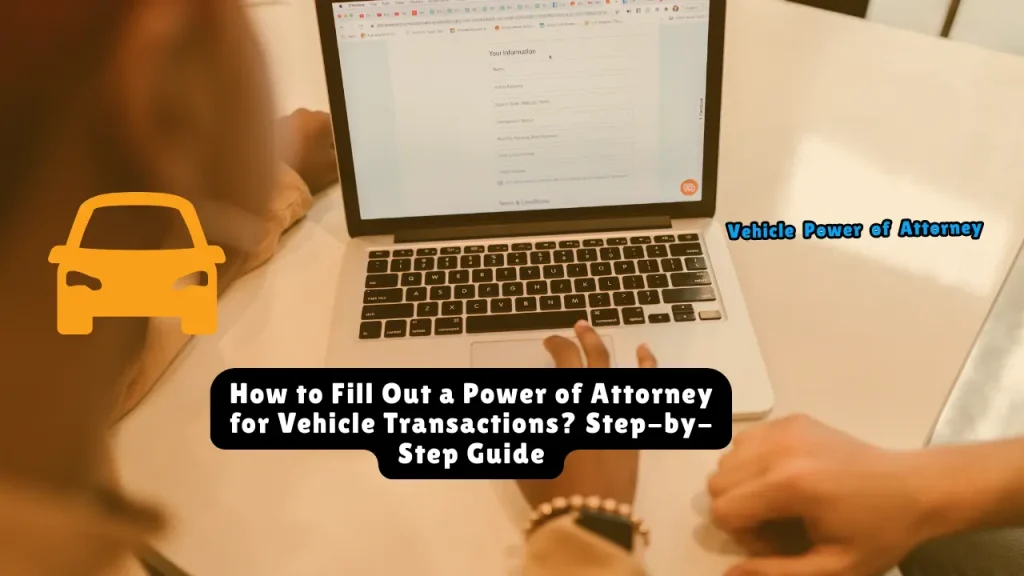How to Fill Out a Power of Attorney for Vehicle Transactions? Step-by-Step Guide
A Power of Attorney (POA) for vehicle transactions allows someone else (your agent) to buy, sell, or transfer a car, truck, or other vehicle on your behalf. To fill one out:
- Use your state’s DMV-approved POA form.
- Specify the vehicle details (VIN, make, model).
- Define the agent’s authority (e.g., signing titles, registering the vehicle).
- Sign in front of a notary or witnesses as required by state law.
Table of Contents
What Is a Vehicle-Specific Power of Attorney?
A vehicle POA is a limited legal document that authorizes an agent to handle specific motor vehicle transactions, such as:
- Selling or purchasing a car.
- Signing a title transfer.
- Registering the vehicle or renewing plates.
- Disposing of a totaled car with an insurance company.
Key Intent:
- Convenience: Useful if you’re unavailable (e.g., deployed military, illness, or living out of state).
- Legally Binding: Ensures the DMV or buyer recognizes the agent’s authority.
Step-by-Step Guide to Filling Out a Vehicle POA
1. Obtain the Correct Form
Most states require a DMV-specific POA form for vehicle transactions. Examples:
- California: Form REG-260 (Vehicle/Vessel Power of Attorney).
- Texas: Form VTR-271 (Statement of Physical or Mental Incapacity or Absence).
- Florida: HSMV 82053 (Power of Attorney to Assign Title).
Download Forms From:
2. Fill Out Principal and Agent Details
- Principal (You):
- Full legal name.
- Address.
- Driver’s license number (if required).
- Agent:
- Full legal name.
- Address.
Example:
“I, [Your Name], of [Your Address], appoint [Agent’s Name], of [Agent’s Address], as my attorney-in-fact for the below vehicle.”
3. Specify Vehicle Information
Include details to limit the agent’s authority to specific vehicles:
- Vehicle Identification Number (VIN).
- Year, make, and model.
- License plate number.
Why This Matters:
Without this, the POA could be rejected by the DMV or buyers.
Related article for you:
Is a Durable Power of Attorney Valid After Death?

4. Define the Agent’s Authority
Check boxes or write instructions for allowed actions:
- ☐ Sign title transfers.
- ☐ Apply for registration.
- ☐ Negotiate sale prices.
- ☐ Obtain duplicate titles.
Limit Scope If Needed:
“This POA applies only to the sale of my 2018 Honda Accord, VIN 1HGCM82633A123456.”
5. Sign and Notarize
- Principal’s Signature: Must match your ID.
- Notary Section: Required in most states (e.g., CA, NY, TX).
- Witnesses: Some states (e.g., Florida) require two witnesses.
Pro Tip:
Bring government-issued ID (driver’s license, passport) to the notary.
Real-Life Example: How a Vehicle POA Works
Scenario:
Sarah, a military member stationed overseas, needed to sell her car in Texas. She used Form VTR-271 to appoint her brother as her agent. He:
- Filled in her details, VIN, and license plate.
- Specified authority to “sign title transfers and negotiate sale.”
- Got the form notarized on base.
- Sold the car legally while Sarah was abroad.
Outcome:
The Texas DMV accepted the POA, and the buyer received a valid title.
Common Mistakes to Avoid
- Using a General POA: Most DMVs reject generic forms—use the vehicle-specific POA.
- Missing Vehicle Details: A POA without a VIN or plate number may be void.
- Ignoring State Rules:
- California: Requires a separate odometer disclosure for sales.
- New York: Mandates a notary but no witnesses.
- Ohio: Allows electronic notarization.
When a Vehicle POA Isn’t Enough
A DMV may reject the POA if:
- The principal is mentally incapacitated (requires guardianship).
- The agent acts outside their scope (e.g., keeping sale profits).
- The form is outdated or incorrectly filled.
Quote from a DMV Expert:
“Vehicle POAs are strict. Cross every ‘t’—missing one number can delay your transaction for weeks.”
— Lisa Gomez, DMV Compliance Officer, California (2023).
How to Revoke a Vehicle POA
- Write a Revocation Letter stating:
“I, [Your Name], revoke all powers granted to [Agent] under the POA dated [Date].” - Sign and notarize it.
- Send copies to:
- The agent.
- Your DMV.
- Any relevant buyers or insurers.
Key Takeaways
- Use your state’s DMV form for vehicle POAs.
- Include VIN, make, model, and license plate.
- Notarize and/or witness as required.
- Revoke in writing if the agent misuses authority.
Bottom Line: A vehicle POA simplifies car transactions but demands precision. Double-check your state’s rules to avoid legal or DMV headaches.
Checklist for Vehicle POAs
- Download the state-specific DMV form.
- List vehicle details (VIN, plate, make/model).
- Define the agent’s exact authority.
- Sign in front of a notary/witnesses.
- Submit copies to the DMV and agent.
Need Help?
- DMV Office Locator: USA.gov DMV Finder
- American Automobile Association (AAA): Free notary services for members.
About the Author

Sarah Klein, JD, is an experienced estate planning attorney who has helped clients with wills, trusts, powers of attorney, and probate matters. At All About Lawyer, she simplifies complex estate laws so families can protect their assets, plan ahead, and avoid legal headaches during life’s most sensitive moments.
Read more about Sarah
